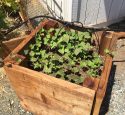The next season of loading up our carts with spring plants, shrubs and trees is only a few months away. One great way to start preparing for spring is to gain a little gardening wisdom, by way of dispelling some myths and misunderstandings.
Our foothills soil is bad for gardening because of the clay (myth): Having used many choice four-letter words and thrown a few shovels across the yard after hours of trying to dig planting holes up here (I am a Bay Area transplant), I won’t argue that ours is not an easy soil to work with. Yes, it’s harder to dig (especially with all of the rock), and yes, too, much clay in a soil can cause drainage and aeration problems with some plants. But the good news is, clay happens to be a nutrient magnet for plants.
The science of why this is so, is more than most gardeners want or need to know; but it has to do with the fact that clay’s surface structure and chemical properties naturally attract many of the essential elements of plant nutrition, such as calcium, magnesium, potassium, hydrogen and iron, among others. “Because clay minerals are so active in nutrient exchanges,” explains the California Master Gardener Handbook, “they are major determinants of the chemical and physical properties of a given soil, and they largely determine how well plants will grow in that soil.”
The best way to plant is to fill the newly dug hole with soil amendments (myth): Recent studies show that nothing is gained by amending backfill with organic matter, fertilizer or other substances. And some “amendment” practices can actually be harmful, like chucking a handful of fertilizer in the planting hole too close to the plant’s roots, which can chemically burn them. Current research tells us that the best planting practice is to use the soil you just shoveled out as backfill and to use organic matter as a mulch spread over the soil after planting to improve soil structure, conserve water and discourage weeds. This planting method will be especially successful if you dedicate much of your garden to native and/or Mediterranean plants. If you can’t live without those heartbreakingly beautiful, fussy non-natives or want to grow vegetables, though, raised beds and amended soil are a must.
Use vitamin B1 when you plant in order to avoid transplant shock (myth): More recent studies have shown that vitamin B1 alone does nothing to speed rooting or prevent transplant shock. Here’s what does work: make sure you have picked a spot that suits the particular plant’s preferred growing conditions in terms of sun exposure and drainage, and minimize stress by planting on relatively cooler days and time of day, and not letting the plant dry out.
You should fertilize landscape trees and bushes every year (myth): While trees and shrubs less than two years old often benefit from fertilizing, research has shown that with few exceptions, mature trees and shrubs in California do not need fertilizer if they are reasonably healthy; that is, the leaves look healthy and there is new shoot growth each year. Usually when fertilizer is needed, only nitrogen is necessary because California soils are most commonly deficient only in nitrogen. When this is the case, the University of California’s Agricultural Extension suggests broadcasting one to three pounds of actual nitrogen per 1,000 square feet of planted area for shrubs or per six inches of trunk diameter for trees. For newly planted trees and bushes, apply 0.2 pounds of nitrogen about three feet by three feet around the base of each plant immediately after planting, again about two months later, then once the following spring.
Rachel Oppedahl is a University of California Cooperative Extension Master Gardener of Tuolumne County.
UCCE Master Gardeners of Tuolumne and Calaveras Counties can answer home gardening questions. Call 209-533-5912 or go to: http://ucanr.edu/survey/survey.cfm?surveynumber=7269 to fill out our easy-to-use problem questionnaire. Check out our website at: http://cecentralsierra.ucanr.edu/Master_Gardeners/ You can also find us on Facebook.



